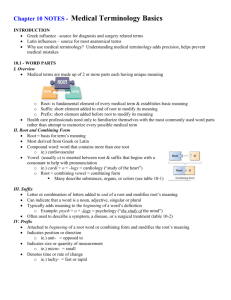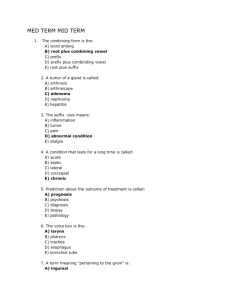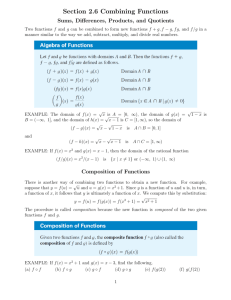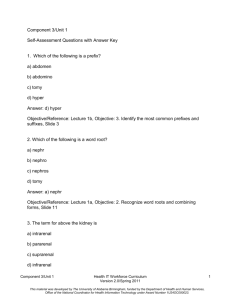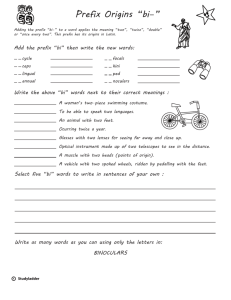File
advertisement
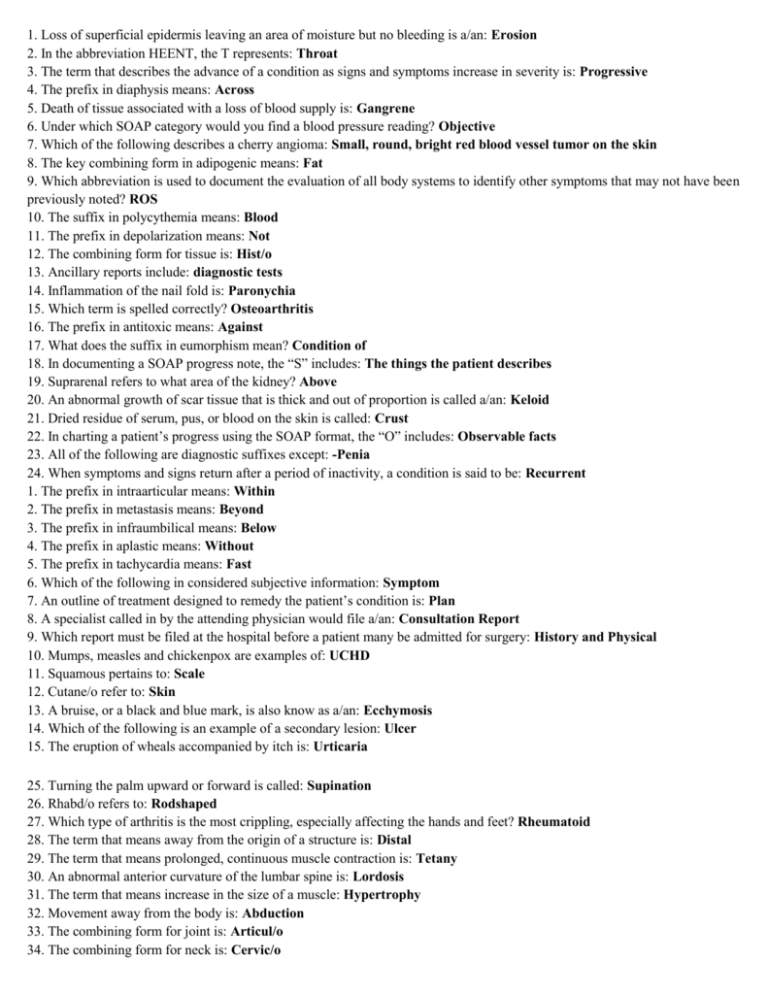
1. Loss of superficial epidermis leaving an area of moisture but no bleeding is a/an: Erosion 2. In the abbreviation HEENT, the T represents: Throat 3. The term that describes the advance of a condition as signs and symptoms increase in severity is: Progressive 4. The prefix in diaphysis means: Across 5. Death of tissue associated with a loss of blood supply is: Gangrene 6. Under which SOAP category would you find a blood pressure reading? Objective 7. Which of the following describes a cherry angioma: Small, round, bright red blood vessel tumor on the skin 8. The key combining form in adipogenic means: Fat 9. Which abbreviation is used to document the evaluation of all body systems to identify other symptoms that may not have been previously noted? ROS 10. The suffix in polycythemia means: Blood 11. The prefix in depolarization means: Not 12. The combining form for tissue is: Hist/o 13. Ancillary reports include: diagnostic tests 14. Inflammation of the nail fold is: Paronychia 15. Which term is spelled correctly? Osteoarthritis 16. The prefix in antitoxic means: Against 17. What does the suffix in eumorphism mean? Condition of 18. In documenting a SOAP progress note, the “S” includes: The things the patient describes 19. Suprarenal refers to what area of the kidney? Above 20. An abnormal growth of scar tissue that is thick and out of proportion is called a/an: Keloid 21. Dried residue of serum, pus, or blood on the skin is called: Crust 22. In charting a patient’s progress using the SOAP format, the “O” includes: Observable facts 23. All of the following are diagnostic suffixes except: -Penia 24. When symptoms and signs return after a period of inactivity, a condition is said to be: Recurrent 1. The prefix in intraarticular means: Within 2. The prefix in metastasis means: Beyond 3. The prefix in infraumbilical means: Below 4. The prefix in aplastic means: Without 5. The prefix in tachycardia means: Fast 6. Which of the following in considered subjective information: Symptom 7. An outline of treatment designed to remedy the patient’s condition is: Plan 8. A specialist called in by the attending physician would file a/an: Consultation Report 9. Which report must be filed at the hospital before a patient many be admitted for surgery: History and Physical 10. Mumps, measles and chickenpox are examples of: UCHD 11. Squamous pertains to: Scale 12. Cutane/o refer to: Skin 13. A bruise, or a black and blue mark, is also know as a/an: Ecchymosis 14. Which of the following is an example of a secondary lesion: Ulcer 15. The eruption of wheals accompanied by itch is: Urticaria 25. Turning the palm upward or forward is called: Supination 26. Rhabd/o refers to: Rodshaped 27. Which type of arthritis is the most crippling, especially affecting the hands and feet? Rheumatoid 28. The term that means away from the origin of a structure is: Distal 29. The term that means prolonged, continuous muscle contraction is: Tetany 30. An abnormal anterior curvature of the lumbar spine is: Lordosis 31. The term that means increase in the size of a muscle: Hypertrophy 32. Movement away from the body is: Abduction 33. The combining form for joint is: Articul/o 34. The combining form for neck is: Cervic/o 1. The combining form brachi/o means: Arm 2. The combining form for lower back is: Lumb/o 3. Dactyl/o is a combing form meaning: Digit 4. Positional and directional terms of reference are based on the body being in a/an: Anatomical Position 5. The term that means toward the head is: Superior 35. A combining form for chest is: Pector/o 36. The combining form referring to a swollen, twisted vein is: Varic/o 37. The circulatory distribution of blood throughout the body is called: Systemic 38. The term for a pain in a limb caused by inadequate blood supply is: Claudication 39. The term used to describe a loss of blood flow to tissue caused by constriction or occlusion of a blood vessel is: Ischemia 40. Which of the following is a congenital anomaly of the heart? Coarctation of the aorta 41. Essential hypertension is also known as: Primary hypertension 42. The joining of two blood vessels to allow flow from one to the other is: Anastomosis 43. The thick muscular layer of the heart is the: Myocardium 44. Which side of the heart handles deoxygenated blood? Right side 1. The combining form meaning fatty paste is: Ather/o 2. The term for heart muscle tissue is: Myocardium 3. An abnormal growth around a valve composed of scar tissue and blood clots is called: Vegetation 4. This term refers to a buildup of fatty substances within the walls of arteries: Atherosclerosis 5. Arrhythmia describes: Irregularity or loss of rhythm of the heartbeat 6. A general term identifying disease of heart muscle is: Cardiomyopathy 7. Which procedure is used to evaluate blood flow to determine the presence of deep vein thrombosis or carotid insufficiency? Doppler sonography 8. This surrounds and encloses the heart in a loose protective sac: Pericardium 9. The valve that allows blood flow into the left ventricles is the: Mitral 10. Which of the following is another term for mitral valve: Bicuspid 45. The disorder caused by incompatibilities between fetal and maternal blood type is called: Erythroblastosis fetalis 46. The timed test to measure the rate at which red blood cells settle or fall through a given volume of plasma is abbreviated: ERS (Erythrocyte sedimentations rate) 47. Hodgkin’s disease is an example of: lymphoma 48. Chyl/o means: Juice 49. The systemic disease caused by infection of microorganism and their toxins in the circulating blood is called: Septicemia 50. Thromb/o is a combining form meaning: Clot 51. The proteiniron compound that has the bonding capabilities for the transport of oxygen and carbon dioxide is: Hemoglobin 52. The red blood cells that transport oxygen and carbon dioxide within the blood stream are called: erythrocytes 53. Granulocytes and agranulocytes are: White blood cells 54. Immun/o is a combining form meaning: Safe 1. The study of blood is: Hematology 2. Which combining form means color? Chrom/o 3. Leukocyte are: White Blood cells 4. Thrombocytes are also know as: Platelets 5. Polymorphonuclear leukocyte is an example of a/an: Neutrophil 6. An increase of immature erythrocytes in the blood is called: Reticulocytosis 7. Which of the following conditions is characterized by the failure of bone marrow to produce red blood cells: Aplastic Anemia 8. A bleeding disorder caused by a defect in clotting factors necessary for the coagulation of blood: Hemophilia 9. Venipuncture is also called: Phlebotomy 10. Red cell morphology involves the study what aspect of red blood cells: Form


